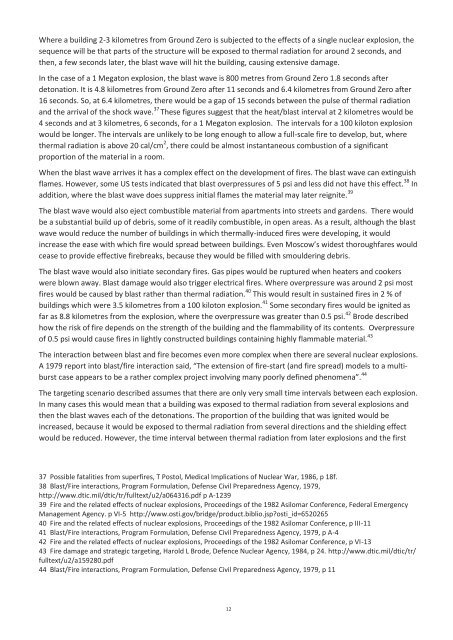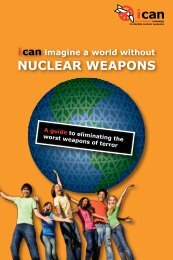If Britain fired Trident - International Campaign to Abolish Nuclear ...
If Britain fired Trident - International Campaign to Abolish Nuclear ...
If Britain fired Trident - International Campaign to Abolish Nuclear ...
- No tags were found...
You also want an ePaper? Increase the reach of your titles
YUMPU automatically turns print PDFs into web optimized ePapers that Google loves.
Where a building 2-3 kilometres from Ground Zero is subjected <strong>to</strong> the effects of a single nuclear explosion, thesequence will be that parts of the structure will be exposed <strong>to</strong> thermal radiation for around 2 seconds, andthen, a few seconds later, the blast wave will hit the building, causing extensive damage.In the case of a 1 Mega<strong>to</strong>n explosion, the blast wave is 800 metres from Ground Zero 1.8 seconds afterde<strong>to</strong>nation. It is 4.8 kilometres from Ground Zero after 11 seconds and 6.4 kilometres from Ground Zero after16 seconds. So, at 6.4 kilometres, there would be a gap of 15 seconds between the pulse of thermal radiationand the arrival of the shock wave. 37 These figures suggest that the heat/blast interval at 2 kilometres would be4 seconds and at 3 kilometres, 6 seconds, for a 1 Mega<strong>to</strong>n explosion. The intervals for a 100 kilo<strong>to</strong>n explosionwould be longer. The intervals are unlikely <strong>to</strong> be long enough <strong>to</strong> allow a full-scale fire <strong>to</strong> develop, but, wherethermal radiation is above 20 cal/cm 2 , there could be almost instantaneous combustion of a significantproportion of the material in a room.When the blast wave arrives it has a complex effect on the development of fires. The blast wave can extinguishflames. However, some US tests indicated that blast overpressures of 5 psi and less did not have this effect. 38 Inaddition, where the blast wave does suppress initial flames the material may later reignite. 39The blast wave would also eject combustible material from apartments in<strong>to</strong> streets and gardens. There wouldbe a substantial build up of debris, some of it readily combustible, in open areas. As a result, although the blastwave would reduce the number of buildings in which thermally-induced fires were developing, it wouldincrease the ease with which fire would spread between buildings. Even Moscow’s widest thoroughfares wouldcease <strong>to</strong> provide effective firebreaks, because they would be filled with smouldering debris.The blast wave would also initiate secondary fires. Gas pipes would be ruptured when heaters and cookerswere blown away. Blast damage would also trigger electrical fires. Where overpressure was around 2 psi mostfires would be caused by blast rather than thermal radiation. 40 This would result in sustained fires in 2 % ofbuildings which were 3.5 kilometres from a 100 kilo<strong>to</strong>n explosion. 41 Some secondary fires would be ignited asfar as 8.8 kilometres from the explosion, where the overpressure was greater than 0.5 psi. 42 Brode describedhow the risk of fire depends on the strength of the building and the flammability of its contents. Overpressureof 0.5 psi would cause fires in lightly constructed buildings containing highly flammable material. 43The interaction between blast and fire becomes even more complex when there are several nuclear explosions.A 1979 report in<strong>to</strong> blast/fire interaction said, “The extension of fire-start (and fire spread) models <strong>to</strong> a multiburstcase appears <strong>to</strong> be a rather complex project involving many poorly defined phenomena”. 44The targeting scenario described assumes that there are only very small time intervals between each explosion.In many cases this would mean that a building was exposed <strong>to</strong> thermal radiation from several explosions andthen the blast waves each of the de<strong>to</strong>nations. The proportion of the building that was ignited would beincreased, because it would be exposed <strong>to</strong> thermal radiation from several directions and the shielding effectwould be reduced. However, the time interval between thermal radiation from later explosions and the first37 Possible fatalities from superfires, T Pos<strong>to</strong>l, Medical Implications of <strong>Nuclear</strong> War, 1986, p 18f.38 Blast/Fire interactions, Program Formulation, Defense Civil Preparedness Agency, 1979,http://www.dtic.mil/dtic/tr/fulltext/u2/a064316.pdf p A-123939 Fire and the related effects of nuclear explosions, Proceedings of the 1982 Asilomar Conference, Federal EmergencyManagement Agency. p VI-5 http://www.osti.gov/bridge/product.biblio.jsp?osti_id=652026540 Fire and the related effects of nuclear explosions, Proceedings of the 1982 Asilomar Conference, p III-1141 Blast/Fire interactions, Program Formulation, Defense Civil Preparedness Agency, 1979, p A-442 Fire and the related effects of nuclear explosions, Proceedings of the 1982 Asilomar Conference, p VI-1343 Fire damage and strategic targeting, Harold L Brode, Defence <strong>Nuclear</strong> Agency, 1984, p 24. http://www.dtic.mil/dtic/tr/fulltext/u2/a159280.pdf44 Blast/Fire interactions, Program Formulation, Defense Civil Preparedness Agency, 1979, p 1112






